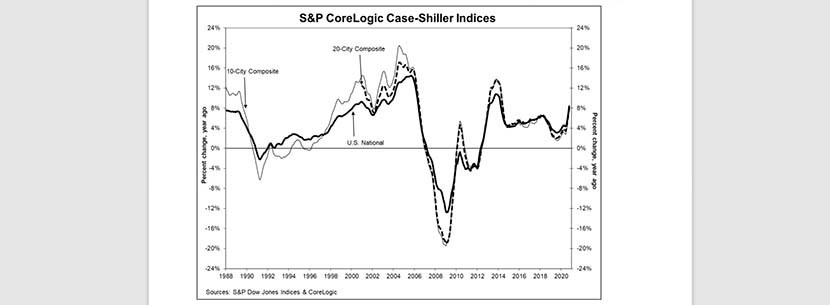
Home Price Strength Remains Strong

Standard & Poor’s, New York, last week reported its S&P CoreLogic Case-Shiller Home Price Index showed home prices posted continued strong growth year over year and month over month.
The U.S. National Home Price NSA Index reported an 8.4% annual gain in October, up from 7.0% in the previous month. The 10-City Composite annual increase came in at 7.5%, up from 6.2% in the previous month. The 20-City Composite posted a 7.9% year-over-year gain, up from 6.6% in the previous month.
Phoenix led all metros with a 12.7% year-over-year price increase, followed by Seattle at 11.7% and San Diego at 11.6% increase. All 19 cities reported higher price increases in the year ending October from a year ago; Detroit data continues to be incomplete.
Month over month the National Index posted a 1.4% increase, while the 10-City and 20-City Composites both posted increases of 1.4% and 1.3% respectively, before seasonal adjustment in October. After seasonal adjustment, the National Index posted a month-over-month increase of 1.7%, while the 10-City and 20-City Composites both posted increases of 1.6%. In October, all 19 cities (excluding Detroit) reported increases before and after seasonal adjustment.
“The surprising strength we noted in last month’s report continued into October’s home price data,” said Craig J. Lazzara, Managing Director and Global Head of Index Investment Strategy with S&P Dow Jones Indices. “We’ve noted before that a trend of accelerating increases in the National Composite Index began in August 2019 but was interrupted in May and June, as COVID-related restrictions produced modestly decelerating price gains. Since June, our monthly readings have shown accelerating growth in home prices, and October’s results emphatically emphasize that trend.”
Lazzara noted the last time the National Composite matched this month’s 8.4% growth rate was more than six and a half years ago, in March 2014. “Although the full history of the pandemic’s impact on housing prices is yet to be written, the data from the last several months are consistent with the view that COVID has encouraged potential buyers to move from urban apartments to suburban homes,” he said. “We’ll continue to monitor what the data can tell us about this question.”
“As the last housing market indicator in 2020, the Case Shiller Index finishes the year on a high note, characterizing the market during this otherwise tumultuous year,” said Selma Hepp, Deputy Chief Economist with CoreLogic, Irvine, Calif. “Looking ahead, 2021 will present a new set of challenges both for the economy and the housing market. While distribution of coronavirus vaccinations is underway, there may still be some bumps along the way to economic recovery.”
Fortunately, Hepp said, critical economic stimulus support appears to also be underway soon, potentially buffering the impacts of recent shutdowns. “Depending on the path of the pandemic over the next few months, policy makers may opt to extend foreclosure moratoriums, in addition to recent extension of rent eviction moratoriums, which will help struggling homeowners and renters,” she said. “Taken together, recent stimulus actions are likely to help housing market demand and ensure continued home price growth.”
